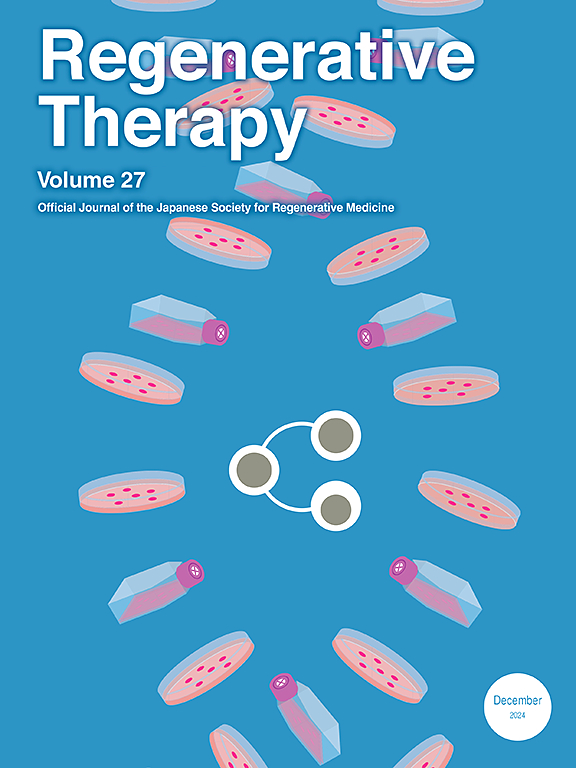丹参酮IIA通过Wnt/β-catenin通路抑制肌腱套损伤中纤维脂肪祖细胞分化并减轻脂肪浸润
IF 3.5
3区 环境科学与生态学
Q3 CELL & TISSUE ENGINEERING
引用次数: 0
摘要
背景纤维脂肪源性祖细胞(FAPs)导致肩袖撕裂(RCT)后肌肉脂肪过度浸润,损害肩功能。丹参酮IIA (Tan IIA)是丹参中的一种主要活性化合物,已知具有抗脂肪生成作用,但其对FAP脂肪生成的影响尚不清楚。方法采用流式细胞术(FACS)分离、培养、Tan IIA处理人肩袖肌FAPs。采用油红O染色和RT-qPCR检测脂质积累和基因表达。单细胞RNA测序鉴定了受影响的FAP亚群,而通路分析和Western blot证实了Wnt/β-catenin通路的激活。然后应用β-catenin抑制剂KYA1797K和XAV-939来评估通路特异性。在体内,RCT模型接受Tan IIA治疗,Plin1染色和甘油三酯量化测量脂肪浸润,步态和跑步机测试评估肩部功能。结果经油红O染色和RT-qPCR检测,stan IIA可抑制FAPs体外成脂分化。单细胞RNA测序表明,Tan IIA降低了特定FAP群体的脂肪生成潜力。富集分析和Western blot结果证实Tan IIA激活了Wnt/β-catenin通路。β-catenin抑制剂的抗脂肪生成作用被逆转。在体内,Tan IIA在RCT模型中显著减少肌肉脂肪浸润并改善肩部功能。结论在RCT研究中,Tan IIA通过激活Wnt/β-catenin信号通路抑制FAP脂肪生成,减少脂肪浸润,增强肩关节功能,提示Tan IIA是一种潜在的治疗方法。本文章由计算机程序翻译,如有差异,请以英文原文为准。
Tanshinone IIA suppresses fibro-adipogenic progenitor differentiation and attenuates fat infiltration in rotator cuff injury via Wnt/β-catenin pathway
Background
Fibro-adipogenic progenitors (FAPs) contribute to excessive muscular fatty infiltration after rotator cuff tears (RCT), impairing shoulder function. Tanshinone IIA (Tan IIA), a major active compound from Salvia miltiorrhiza Bunge, has known anti-adipogenic effects, yet its impact on FAP adipogenesis remains unclear.
Methods
Human FAPs from rotator cuff muscles were isolated via FACS, cultured, and treated with Tan IIA. Adipogenic differentiation was assessed with Oil Red O staining and RT-qPCR for lipid accumulation and gene expression. Single-cell RNA sequencing identified affected FAP subpopulations, while pathway analysis and Western blots confirmed Wnt/β-catenin pathway activation. β-catenin inhibitors KYA1797K and XAV-939 were then applied to evaluate pathway specificity. In vivo, RCT models received Tan IIA treatment, with Plin1 staining and triglyceride quantification measuring fatty infiltration, and gait and treadmill tests assessing shoulder function.
Results
Tan IIA reduced adipogenic differentiation of FAPs in vitro, as shown by Oil Red O staining and RT-qPCR. Single-cell RNA sequencing indicated that Tan IIA reduced adipogenic potential in specific FAP populations. Enrichment analysis and Western blot results confirmed Wnt/β-catenin pathway activation by Tan IIA. Anti-adipogenic effects were reversed with β-catenin inhibitors. In vivo, Tan IIA significantly reduced muscular fatty infiltration and improved shoulder function in RCT models.
Conclusion
Tan IIA inhibits FAP adipogenesis through Wnt/β-catenin signaling activation, reducing fatty infiltration and enhancing shoulder function in RCT, suggesting Tan IIA as a potential treatment.
求助全文
通过发布文献求助,成功后即可免费获取论文全文。
去求助
来源期刊

Regenerative Therapy
Engineering-Biomedical Engineering
CiteScore
6.00
自引率
2.30%
发文量
106
审稿时长
49 days
期刊介绍:
Regenerative Therapy is the official peer-reviewed online journal of the Japanese Society for Regenerative Medicine.
Regenerative Therapy is a multidisciplinary journal that publishes original articles and reviews of basic research, clinical translation, industrial development, and regulatory issues focusing on stem cell biology, tissue engineering, and regenerative medicine.
 求助内容:
求助内容: 应助结果提醒方式:
应助结果提醒方式:


